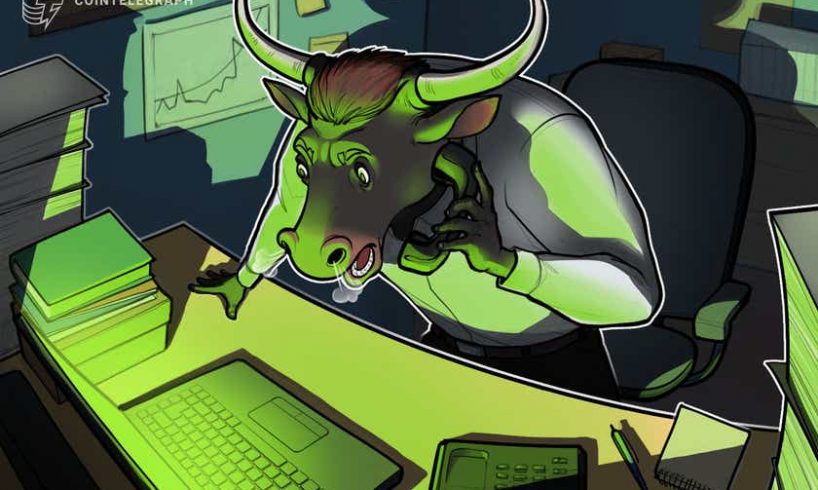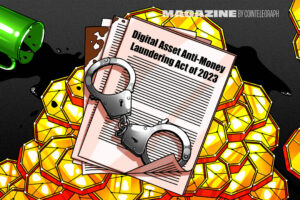
Bitcoin (BTC) starts a new week in a strange place — one which is eerily similar to where it was this time last year.
After what various sources have described as an entire twelve months of “consolidation,” BTC/USD is around $42,000 — almost exactly where it was in week two of January 2021.
The ups and downs in between have been significant, but essentially, Bitcoin remains in the midst of a now familiar range.
The outlook varies depending on the perspective — some believe that new all-time highs are more than possible this year, while others are calling for many more consolidatory months.
With crypto sentiment at some of its lowest levels in history, Cointelegraph takes a look at what could change the status quo on shorter timeframes in the coming days.
Will $40,700 hold?
Bitcoin saw a trying weekend as the latest in a series of abrupt downward moves saw $40,000 support inch closer.
Data from Cointelegraph Markets Pro and TradingView showed BTC/USD hitting $40,700 on major exchanges before bouncing, a correction which has since held.
Ironically, it was that very level which was in focus on the same day in 2021, that nonetheless coming during what turned out to be the more vertical phase of Bitcoin’s recent bull run.
Last September also returned the focus to $40,700, which acted as a turning point after several weeks of correction and ultimately saw BTC/USD climb to $69,000 all-time highs.
Now, however, the chances of a breakdown to the $30,000 zone are unreservedly higher among analysts.
“Weekly Close is just around the corner,” Rekt Capital summarized alongside a chart with target levels.
“Theoretically, there is a chance that $BTC could perform a Weekly Close above ~$43200 (black) to enjoy a green week next week. Weekly Close under ~$43200 however & BTC could revisit the red area below.”BTC/USD annotated candle chart. Source: Rekt Capital/ Twitter
Bitcoin ultimately closed at $42,000, since hovering at around that level in what could turn out to be some temporary relief for bulls.
“I think market puts in a lower high,” fellow trader and analyst Pentoshi forecast, adding that he believes $40,700 will ultimately fall.
An increasingly alluring target, meanwhile, lies at last summer’s $30,000 floor.
Consensus forms over dire outlook for cash
The macro picture this week is particularly complicated for risk asset fans, with Bitcoin and altcoins no exception.
What the future holds, however, varies considerably from one pundit to another.
The United States Federal Reserve is broadly seen to start raising interest rates in the coming months, this making investors de-risk and causing a headache for crypto bulls. “Easy money,” which began flowing in March 2020, will now be much harder to come by.
The bearish viewpoint was summarized neatly by ex-BitMEX CEO, Arthur Hayes, in his latest blog post last week.
“Let’s forget what non-crypto investors believe; my read on the sentiment of crypto investors is that they naively believe network and user growth fundamentals of the entire complex will allow crypto assets to continue their upward trajectory unabated,” he wrote.
“To me, this presents the setup for a severe washout, as the pernicious effects of rising interest rates on future cash flows will likely prompt speculators and investors at the margin to dump or severely reduce their crypto holdings.”
This week sees the U.S. consumer price index (CPI) data for December released, numbers which will likely feed into the story of surprise inflation gains.
Hayes is far from alone in worrying over what the Fed may bring to crypto this year, with Pentoshi among others likewise calling a temporary end to the bull run.
“And the final question is, can crypto ignore the Fed if it decides to go all out wielding a deflationary machete? I doubt it,” analyst Alex Krueger concluded in a series of tweets on the issue this weekend.
“‘Don’t fight the Fed’ applies both ways, up and down. If the Fed is *too hawkish* then Houston, we have a problem.”
There were some optimists left in the room. Dan Tapiero, Founder and CEO of 10T Holdings, told followers to “ignore” the recent rout and focus on an unchanged long-term investment opportunity.
“Most bullish macro backdrop in 75 years,” he said.
“Booming economy supported by massive negative real rates. Fed will never equalize rates with inflation. Stay long stocks and Bitcoin and ETH. Hodl through short term volatility. Real Dollar cash savings will continue to lose value.”
Here’s a look at the Effective Fed Funds Rate and Inflation Rates when the Unemployment Rate was at 3.9%, as it is today.
Find the outlier… pic.twitter.com/zU1zRj1uXC
— Charlie Bilello (@charliebilello) January 7, 2022
Tapiero highlighted data compiled by Charlie Bilello, founder and CEO of Compound Capital Advisors.
RSI hits two-year lows
Amid the gloom, not everything is pointing to a protracted bearish phase for Bitcoin specifically.
As Cointelegraph has been reporting, on-chain indicators are calling for upside in droves — and historical context serves to support those demands.
This week, it’s Bitcoin’s relative strength index (RSI) which continues to headline, reaching its lowest levels in two years.
#Bitcoin RSI has been this low just 2 other times in the last 2 years. Looks like a bottom is near and bounce due. Let’s see pic.twitter.com/qhQ1pD8yEl
— Bitcoin Archive (@BTC_Archive) January 9, 2022
RSI is a key metric used to determine whether an asset is “overbought” or “oversold” at a given price point.
Plumbing the depths at $42,000 suggests that such a level really is considered too extreme by the market, and a rebound should occur to balance it.
By contrast, last January, RSI was sky high and conversely well within “overbought” territory, while BTC/USD traded at the same price.
“The Bitcoin RSI is on the lowest point in 2 years on the daily. March 2020 & May 2021 were the last ones. And people flip bearish here / want to short,” a hopeful Cointelegraph contributor Michaël van de Poppe commented.
BTC/USD 1-day candle chart (Bitstamp) with RSI. Source: TradingView
Cointelegraph noted similarly bullish hints on the monthly RSI chart last week.
Hash rate recoups Kazakhstan losses
Another blip from last week already “curing itself” comes from the realm of Bitcoin fundamentals.
After hitting new all-time highs throughout recent weeks, Bitcoin’s network hash rate took a hit when turbulence in Kazakhstan comprised internet availability.
Kazakhstan, home to around 18% of hash rate, has since stabilized, allowing the hash rate to mostly return to prior levels of 192 exahashes per second (EH/s).
At one point down to 171 EH/s, responses to what may have reminded some of last May’s China mining ban appear to have lifted hash rate and preserved record-breaking miner participation.
Bitcoin’s network difficulty, despite the upheaval, still managed to put in a modest increase this weekend and is currently on track to do so again at its next automated readjustment in just under two weeks.
Live Bitcoin hash rate chart screenshot. Source: MiningPoolStats
“Going up forever,” on-chain analyst Dylan LeClair commented about the classic mantra, “price follows hash rate.”
For context, China’s mining rout caused hash rate to decline by 50%. It took around six months to recoup the losses.
“What if…?”
Someone who has long been saying that it’s high time for a Bitcoin trend reversal is quant analyst PlanB, creator of the stock-to-flow-based BTC price models.
Related: Top 5 cryptocurrencies to watch this week: BTC, LINK, ICP, LEO, ONE
Currently weathering a test of his creations — and the accompanying storm of social media criticism — PlanB nonetheless remains more optimistic than most when it comes to mid to long-term price action.
“I know some people have lost faith in this bitcoin bull market,” he acknowledged this weekend.
“However we are only halfway into the cycle (2020-2024). And although BTC experiences some turbulence at $1T, the yellow gold cluster at S2F60/$10T (small black dots are 2009-2021 gold data) is still the target IMO.”Stock-to-flow cross-asset (S2FX) chart. Source: PlanB/ Twitter
He was referring to the stock-to-flow value for Bitcoin, gold and other assets as part of his stock-to-flow cross-asset (S2FX) model, which calls for an average BTC/USD price of $288,000 during the current halving cycle.
Closer to home, however, a more simplified comparison between Bitcoin this cycle and its two previous ones saw a feasible trajectory beginning with a U-turn now.
What if … pic.twitter.com/te36HkFAbQ
— PlanB (@100trillionUSD) January 9, 2022
A separate model, the floor model, which demanded $135,000 per bitcoin by the end of December, has now been discarded after failing to hit its target for the first time ever in November.
















